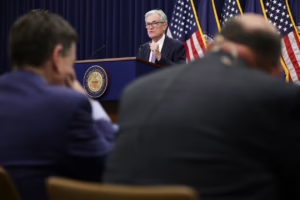For the second consecutive month, the Federal Reserve’s preferred U.S. inflation gauge is predicted to show little to no increase, but the fight to manage the cost of living may not be finished yet.
When the data is announced on Friday, it is expected that the personal-consumption expenditures (PCE) index will increase by a meager 0.1% in April. In March, there was no increase in the price gauge.
In the 12-month period ending in April, the U.S. inflation rate may fall from 2.3% to 2.2% and approach prepandemic levels if Wall Street projections are correct.
Although a 0.1% increase in core PCE, a related metric, is also anticipated, the 12-month rate would still be slightly higher at 2.6%.
The core rate is thought to be a more accurate indicator of future U.S. inflation since it does not include the volatile food and energy categories.
Indeed, it’s good news. Following years of sharp price increases that caused millions of Americans to suffer greatly, the Fed is working to bring the inflation rate back down to 2% or below. In 2022, the PCE index soared to 7.3%, a 40-year high.
However, the fight is far from over.
For starters, the economy is only now beginning to feel the inflationary effects of increased U.S. tariffs.
Even when President Trump loosened the worst of the tariffs, many analysts estimate that inflation may begin to rise back to 3%, so it may take many months or longer to see the full effects.
This week, a U.S. judge decided that Trump had overreached his emergency powers to apply the majority of the tariffs, which could be even more positive news. The legal battle may go on, though, as the White House intends to appeal.
In any event, a recent study that is gaining traction among economists claims that the price spike from 2021 to 2023 has also left firms and individuals uncertain about the Fed’s ability to bring inflation back to low prepandemic levels.
Despite statements made by senior Fed officials, the analysis indicates that inflation expectations have become “unanchored.” In other words, they are no longer certain that inflation will either return to normal or remain extremely low for an extended period of time.
The United States recently experienced a similar circumstance in the 1970s and early 1980s, when a series of isolated incidents led to the worst inflation spike in the nation’s history. For years, there was high inflation, and each time it seemed to be about to slow down, it erupted once again.
“So we find ourselves in the same situation as in the mid-1970s,” said Olivier Coibion and Yuriy Gorodnichenko in their article “Inflation expectations and monetary policy: What have we learned and to what end?”
The two authors think they would not like what they discovered.
They came to the conclusion, “Once again, any significant spark could reignite the fire,” “And with rising import prices already happening, the fire has likely already begun.”





